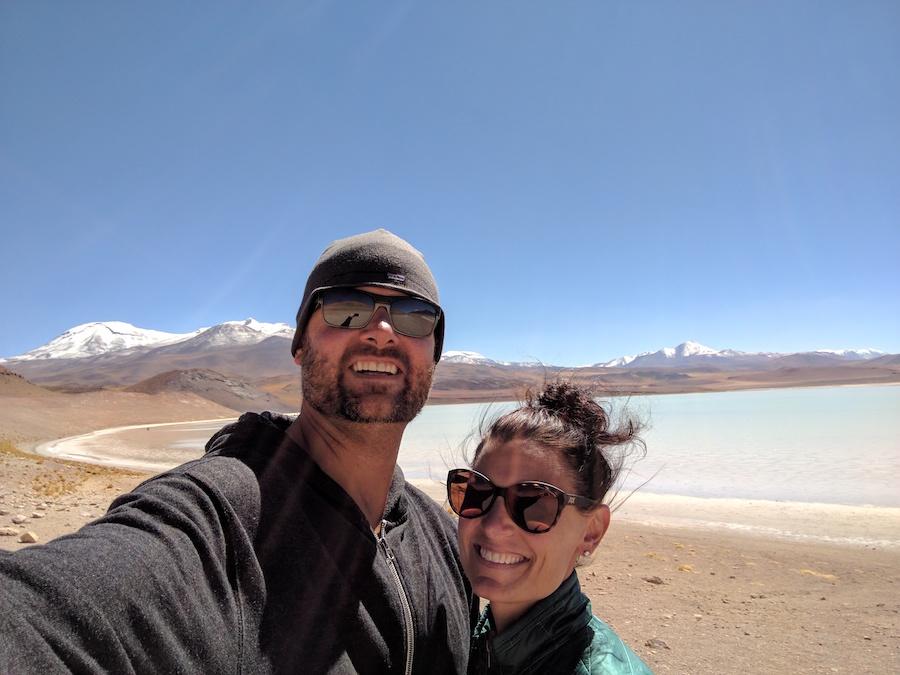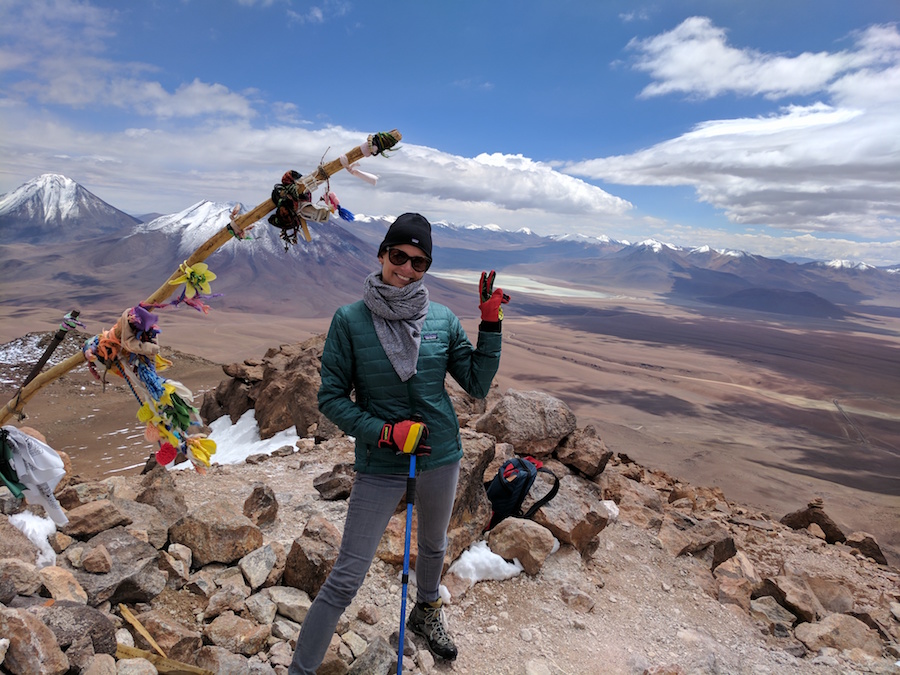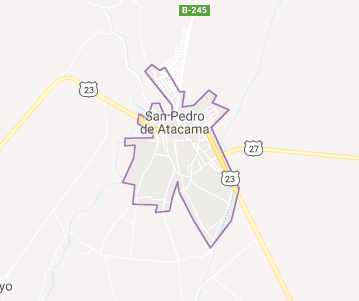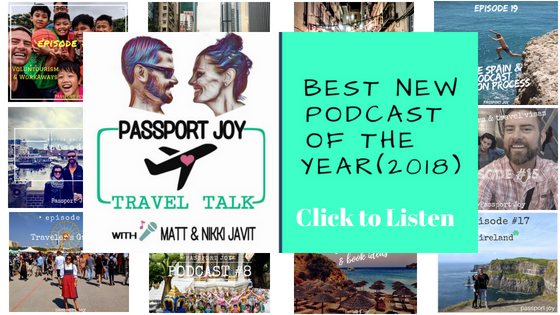San Pedro de Atacama, Chile is in northeast Chile surrounded by a plethora of mind-blowing landscapes and attractions. Clear lakes, volcanoes, desert land, hot springs, and salt flats. San Pedro de Atacama is a dream for your camera and you will be looking back at the photos you take for years to come.
If you would rather hear about our 5 weeks in Chile, listen to the Podcast Episode – Podcast 28: Chile Travel – Santiago, Valparaiso, San Pedro de Atacama (& Other Beauty)
When I first arrived at San Pedro de Atacama, I felt like I had arrived somewhere in the Southwestern US. There are one-story, adobe, white buildings, red, dusty roads, mud-splashed cars and trucks driving through the streets flicking red dust into the air as they drive by.
There are many people walking alongside the roads trying to get from point A to point B and one can easily decipher the locals from the travelers by the large packs they carry on their backs. The air is dry and there is always a slight breeze that brings a small cloud of dust along with it…this dust ends up on your clothes, in your hair, and in your lungs. I found myself with a grit in my mouth various times throughout our stay in San Pedro de Atacama.
The desert mornings and nights are cool and crisp, one needs to wear a jacket and/or layers to keep warm. On the contrary, the afternoons are quite warm and you will find yourself changing from winter, layered clothes to summertime clothes. For some, the altitude (2,400 meters or 7,900 feet) and the varying temperatures can make walking and breathing a challenge.
The main road in San Pedro de Atacama, Caracoles, is full of restaurants, markets, bazaars, and tour agencies. Although this part of town does feel a bit touristy, the rest of San Pedro de Atacama remains to be a sleepy, little town located in the middle of the world’s driest desert with its dusty streets and slow paced life.

We spent four amazing days in San Pedro de Atacama. There were several times during our travels throughout the Atacama desert that I felt as if I had been transported to the moon. It was as if I had traveled to another planet. There were days when we would trek through sand, dirt, mud, salt, rock, and the snow. If you have a chance to visit San Pedro de Atacama, I promise it will not disappoint.
Night #1
Star Gazing
The high elevations of San Pedro de Atacama coupled with great weather (some parts of Atacama have never seen rain), equates to THE clearest view of the stars on earth. The European Southern Observatory (ESO) operates the Atacama Large Millimeter/submillimeter Array (ALMA), the largest astronomical project in existence, with 66 antennas, from this very desert.
We booked a private stargazing tour through TripAdvisor. We were picked up by our hosts’ private driver at our hostel around 10 pm and taken to the host’s private, star gazing observatory grounds. As we got out from the driver’s car, it was pitch black outside except for a wheelbarrow with a small campfire we could see off in the distance. We were greeted by J.P. and his wife, our hosts. Our hosts had a table set up with wine, cheese, crackers, and olives that was lit by a single strand of twinkling star lights.
At this point, our eyes started to adjust to the dark, night sky and we soon realized that the entire sky was full of stars and right above us as plain as day was the Milky Way. It was breathtaking. Within minutes of our eyes adjusting, there were millions upon millions of stars surrounding us from every angle we looked. It was as if we were being wrapped in a blanket of stars.
Travel Tip: Sometimes it pays to spend a little now for big benefits over the long haul. That is how Matt feels about his Mizzen and Main pants. Durable and extremely versatile. Going out to a restaurant, for church on Sunday, or climbing a mountain. They work in all situations. Breathable and comfortable, they work well in all climates too. Its value over budget in this case. Find this and other tips on our Travel Tools page.
The tour started with a brief introductory lesson in astronomy to point out the major constellations and galaxies and to discuss the difference between the northern and southern hemispheres and why we could not see certain stars in certain areas of the world. Our host had a laser pointer in which she used to point at the night sky and tell us exactly what we were about to look at through the telescope, magnified 600 times. Throughout the evening we were able to observe open and closed clusters, Jupiter and its moons, nebulae, galaxies, and several other things invisible to the naked eye. Our tour lasted approximately 3 hours.
Day #1
Los Flamencos National Reserve
Salar de Atacama – Known for its white, salt surface that is produced by the evaporation of its water and its landscape that has been shaped throughout time by the elements (rain, wind, etc.). You can see various colors throughout the flats as a result of the minerals, clay, and a salt mixture. This is also a natural reserve for flamingos (although we did not see any). We did, however, see the brine shrimp that the flamingos eat that cause their feathers to change from grey to pink.
Piedras Rojas (Red Stones) & Laguna Salar de Talar – Here you can see beautiful views of Cerro Medano and volcano Caichinque contrasted against the bright, red rocks that were created from volcanic lava and ash oxidizing in the air. The crystal clear, green waters of Laguna Salar de Talar and the white sandy shoreline within the red rocks makes this place a photographer’s dream.
https://youtu.be/P3ca_vAajE8
Miscanti y Miňiquees Lagoons – Nestled within the grass that is shades of yellow and green, these crystal clear, turquoise lagoons were both named after the volcanoes above them and are located 4,000 meters above sea level.
Plaza de Toconao, “place of stones” – This town is located on the northeast corner of the Atacama Salt flats and has less than 800 inhabitants. Here we were able to see the Bell Tower of San Lucas, the Church of San Lucas, and we got to meet the pet llama, “Stephanie”, of the supermarket owner.
Day #2
El Tatio Geyser Field- Calama, Chile
Our tour guide picked us up at 4:30 am in order to make it to El Tatio Geyser Field by 7 am. Located 4,200 meters above sea level, the outside temperature was -1C. You can see tourists walking amongst the steam eruptions emanating from the deep earth. There are places in the ground where one can feel the hot steam being pumped out from the ground with your bare hand. Be careful…the steam is very hot!
Puritama Hot Springs
Although the ambient temperature outside may be 0C (32F), these hot springs have 33C (91F) water you can dip into and enjoy. The waters are said to also have healing powers for ailments such as rheumatoid arthritis due to their high mineral concentration.
Pueblo de Machuca
We stopped at this small town, said to have only 12 inhabitants, to get a bite to eat and to see the Iglesia de Machuca. Here the main activity of those who live here is the grazing of llamas. However, in recent years, with the boost of tourism, the people of Machuca have started to sell their handmade goods (scarves, hats, blankets, leather goods, etc) along with their llama and alpaca meat. They also sell cheese (goat and cow cheese) and pino empanadas! The Machuca Church, dating back to 1933, is a tiny, white church with a straw roof and intense, aquamarine blue colored doors.
Day #3
Valle de la Luna (Valley of the Moon)
Salt Caves – The walls throughout the cave are covered with edible salt. Navigating through the salt caves is not an easy task. One must pay attention to the unpredictable trails throughout the caves so as to not trip and fall. The paths are wide in some areas and in others, you must get on your hands and knees to make it through the other side.
Portions of the cave are illuminated by a flicker of sunlight that creeps in if the rock walls break away and allow it to. Otherwise, there are portions of the cave that are in complete darkness as the rock walls are completely closed off from the outside world, not allowing a drop of sunlight in; there is only a heavy darkness and silence that falls upon you and the air is thick and filled with dust. When you make it through the salt caves and ascend to the top, the view from the top is spectacular!
Las Tres Marias (The Three Mary’s) – These are quartz and granite rock sculptures that guard the entrance to the Valley of the Moon. In the sand around these sculptures, the sand twinkles from the hidden salt fragments.
Valle de la Muerte (Death Valley) – About an hour before sunset, the air is starting to get cooler, the warm sun is still shining down on our skin and we are standing on the top of a rock ledge overlooking the Salt Mountain Range and Death Valley. The lookout provides a panoramic view of the entire valley. The landscape appears to be a never-ending sea of rock and sand formations that collide with each other. When you look out into the horizon as far as the eye can see, the Atacama sky melts into the Andes mountains along with its snowcapped peaks. The views are breathtaking.
Day #4
Cerro Toco Hike
Considered one of the “easiest” mountains to climb, Cerro Toco’s elevation clocks in at 5,604 meters or 18,386 feet. This climb took 3 hours to ascend and approximately 2 hours to descend. In order to avoid altitude sickness, one MUST ascend the mountain slowly to allow your body to acclimate to the change in altitude. Make sure to bring the appropriate hiking gear for this type of excursion as the temperatures on this mountain are 0C.
A warm winter coat, gloves, scarf, hat, and hiking boots are necessary to complete this day trip and for you to feel safe on your journey up to this beautiful mountain. The mountain is covered in both ice and snow and without the appropriate shoes, it is very difficult to navigate and very easy to slip and fall and lose your footing.
The wind was also very fierce the higher you ascend up the mountain so having your head, ears, and face properly protected from the wind is a good idea. You may also want to consider wearing sunglasses and a high protection SPF sunscreen and reapply once every 50 minutes to protect yourself from sunburn.
Note: Our guide told us that during the first hour, it is the most difficult. He told us that during this time you may feel tired and it may feel hard to breathe but you must fight through this and let your body adjust to the change in altitude. I personally did not have any problems DURING our climb, however, AFTER our climb I did get a bad headache but I was able to sleep it off with a couple of Advil. A headache was well worth the view from over 18,000 feet above!

Traveled March 2017



Matt, looks like you are having fun and learning a lot about life and cultures. Enjoy
Mike Pleiman